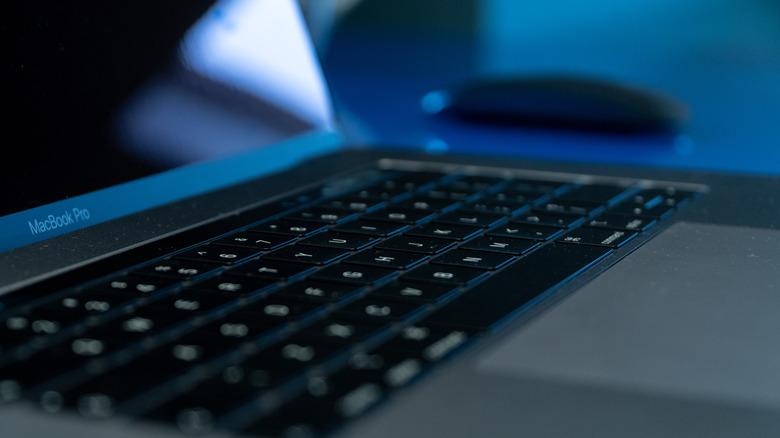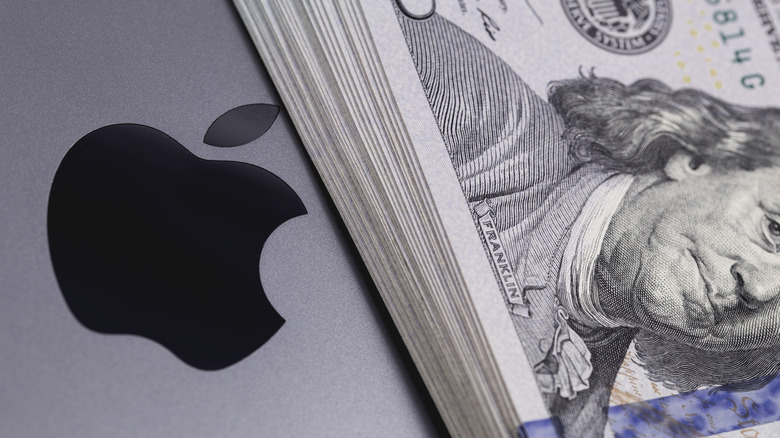The Apple Product That Was So Bad It Lead To Lawsuits
In March 2015, Apple unveiled the MacBook, a new 12-inch notebook that joined the MacBook Air and MacBook Pro lineups. Apple marketed the MacBook as its "thinnest and lightest Mac ever," armed with features like a compact USB-C port, new Force Touch trackpad, and full-size keyboard that was 34 percent thinner than its previous Mac keyboards. This new keyboard featured a "butterfly mechanism," and would go on to become one of the most controversial Apple products of all time, eventually leading to a class-action lawsuit and multi-million dollar settlement.
The butterfly keyboard was Apple's attempt to re-engineer the conventional scissor-switch keyboard. According to Apple, it was 40 percent thinner than conventional scissor keyboards, while being up to four times more stable. Apple also claimed the butterfly keyboard was more precise than other keyboards, evenly distributing finger pressure no matter where your finger landed on the keycap. The butterfly keyboard was used in all MacBook models, as well as MacBook Air and MacBook Pro models launched between 2016 and 2019.
Why the butterfly keyboard was an epic failure
Before getting into why the butterfly keyboard failed, it's essential to understand how scissor-switch keyboards work. Scissor switches are placed close to the actual keyboard, making them much shorter than other types of keyboards, such as mechanical keyboards. This makes them ideal for use in laptops. Scissor-switch keys feature an interlocking design consisting of two parts in an X-shape. When the keys are pressed, the two parts close like a scissor. This keyboard type doesn't require a firm press, but the mechanism results in less travel.
Apple's butterfly keyboard featured a hinge in the middle of each key, with the V-shape components resembling a butterfly's wings. While this design resulted in a much thinner design and a more clicky feeling, it also meant a noticeable gap under each key. As a result, food, dirt, and debris could easily accumulate under the keys, causing all sorts of problems. Many users complained of keys with a "sticky" feeling, some had issues with repeated letters, and others found that some keys stopped working entirely.
Despite the complaints and widespread criticism, Apple continued making and selling MacBooks with butterfly keyboards for five years. During this time, it tweaked everything from the design to the materials in an attempt to fix the butterfly keyboard, but nothing seemed to work.
The $50 million butterfly keyboard lawsuit
The butterfly keyboards were so bad that Apple launched an official keyboard service program. The program covered issues like keys unexpectedly repeating, not working, and being "sticky" or unresponsive. It applied to all Mac notebooks with a butterfly keyboard, ranging from the 2015 MacBook to the 2019 MacBook Pro. Affected users could take their MacBooks to an Apple Authorized Service Provider and have either a few keys or their entire keyboard replaced free of charge.
Despite the service program, butterfly keyboard complaints were so widespread that they eventually led to a class-action lawsuit. Customers alleged that Apple knew about the keyboard's issues, but attempted to conceal this information, continuing to sell and launch new models with the faulty mechanism. In addition, Apple's service program only replaced affected keyboards with new butterfly keyboards, which wasn't a long-term solution. The lawsuit represented about 15 million affected MacBook users, and Apple finally agreed to a $50 million settlement in 2022. MacBook users who had keycaps or the topcase replaced could claim up to $395.
Apple went back to the scissor-switch keyboard with the 13-inch MacBook Pro in 2020, but the damage had already been done. Millions of MacBooks with butterfly keyboards had been sold, and many are still in use. Apple's keyboard service program only covers eligible models for four years after the first retail sale, which means users of older MacBooks are stuck with the butterfly keyboard until they upgrade to a newer model.


